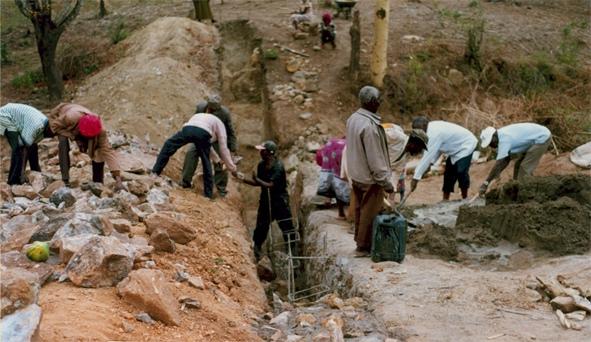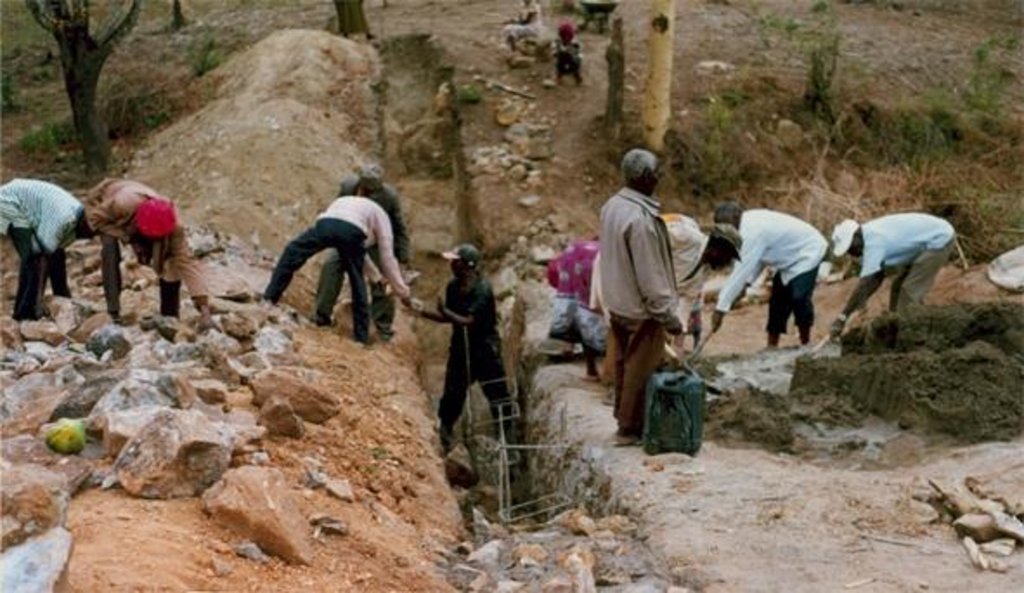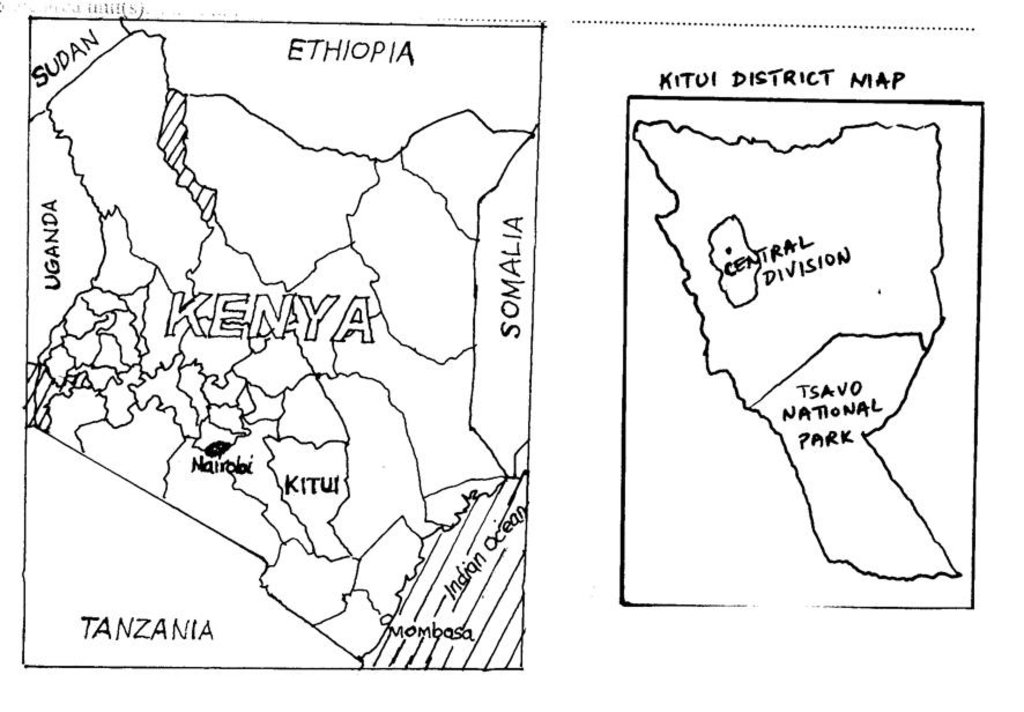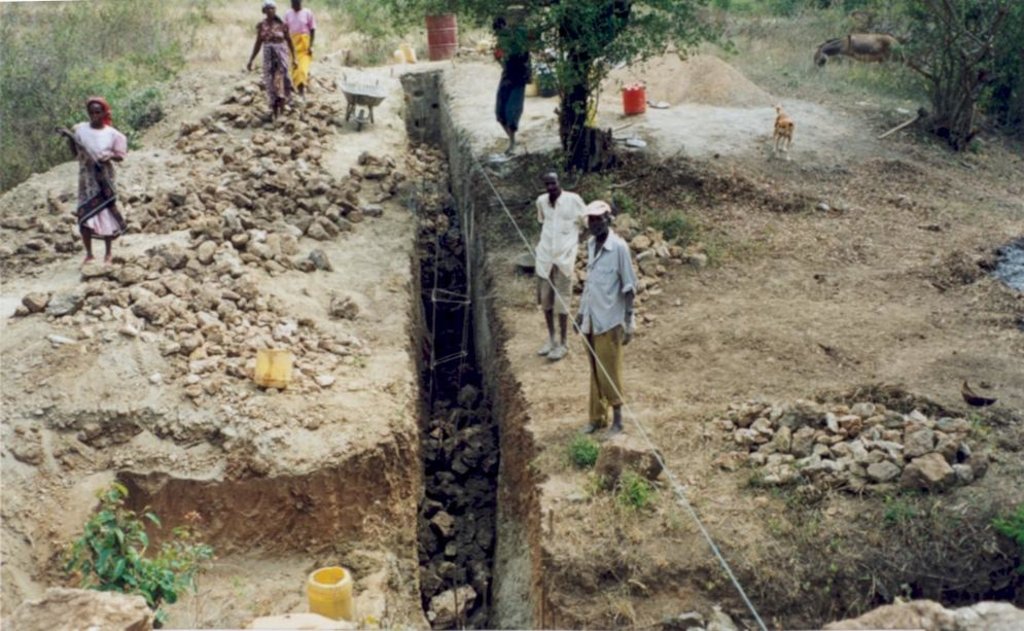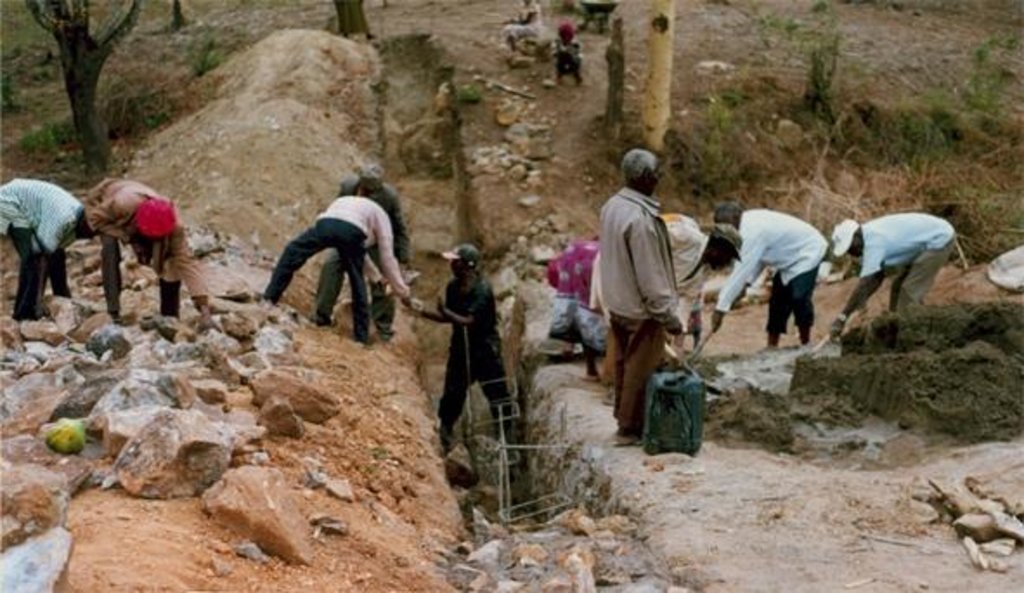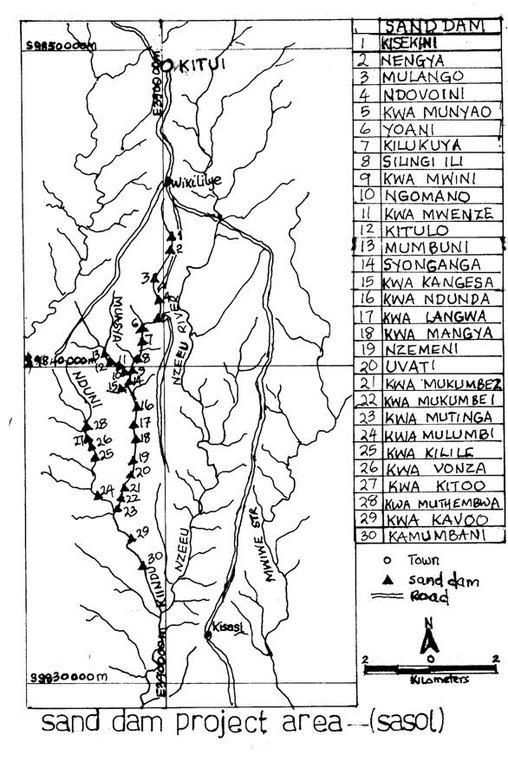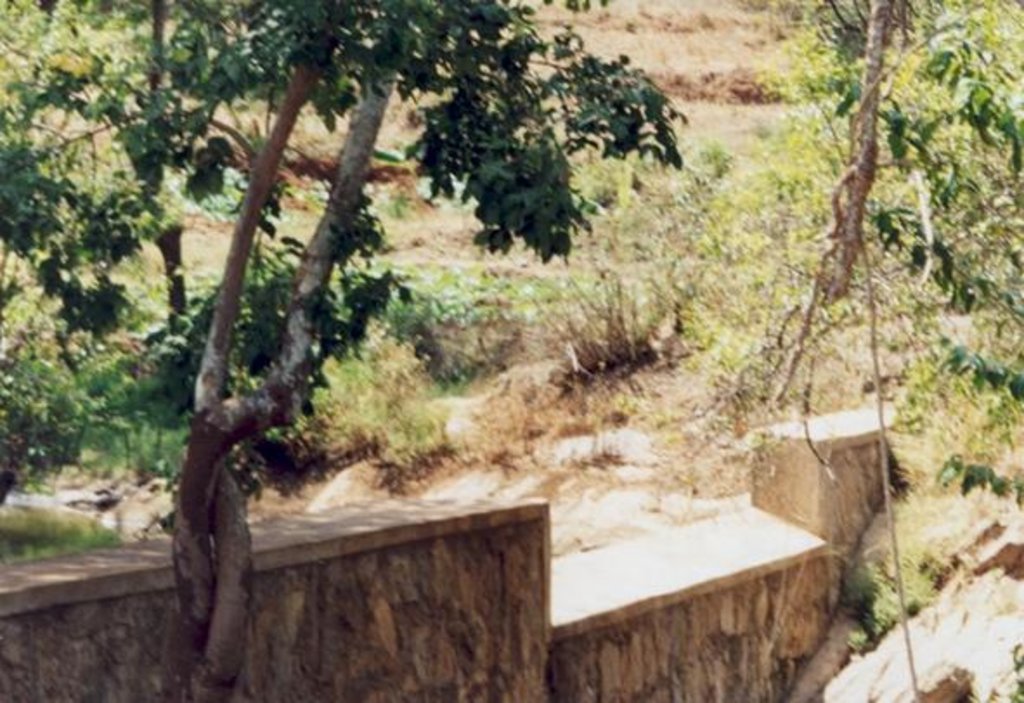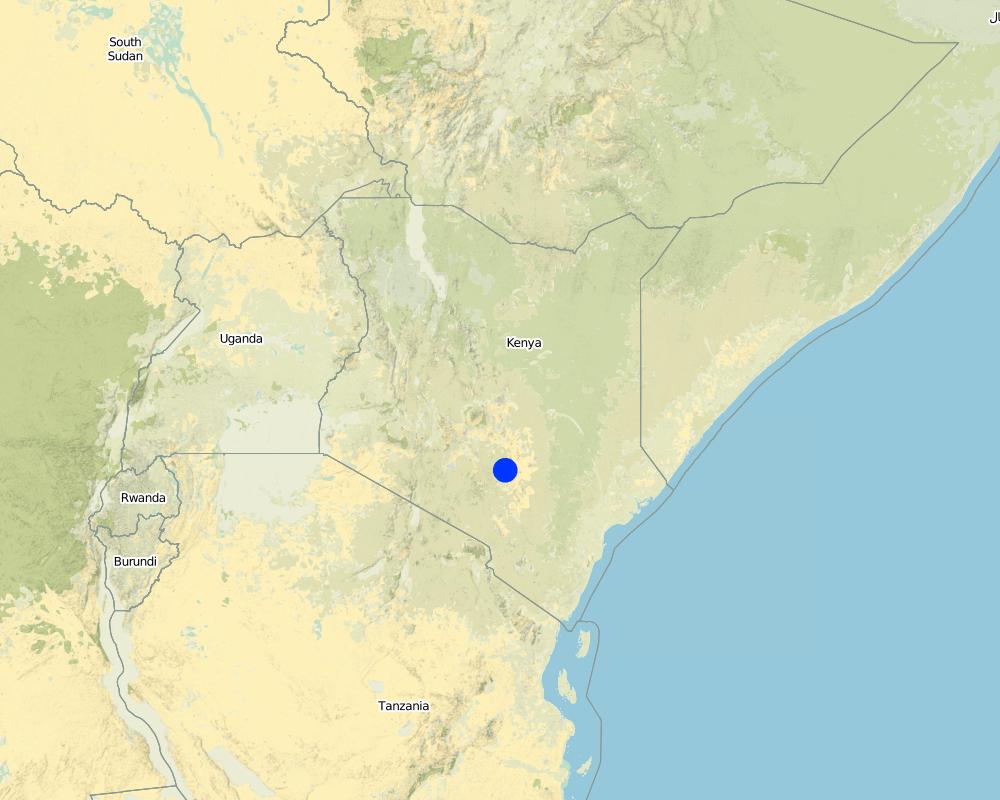SASOL community approach - for sand dams in Kitui [Кения]
- Создание:
- Обновить:
- Составитель: Donald B. Thomas
- Редактор: –
- Рецензент: Fabian Ottiger
approaches_2358 - Кения
Просмотреть разделы
Развернуть все Свернуть все1. Общая информация
1.2 Контактные данные специалистов и организаций, участвующих в описании и оценке Подхода
Специалист по УЗП:
Mutiso Sam
sasol@kenyaweb.com
SASOL Foundation
PO Box 85 Kitui Kenya
Кения
Название организации (-ий), содействовавших документированию/оценке Подхода (если применимо)
Sahelian Solutions Foundation (SASOL) - Кения1.3 Условия, регламентирующие использование собранных ВОКАТ данных
Составитель и ответственный/-ые специалист(-ы) согласны с условиями, регламентирующими использование собранных ВОКАТ данных:
Да
1.4 Ссылка (-и) на Анкету (-ы) по Технологиям УЗП
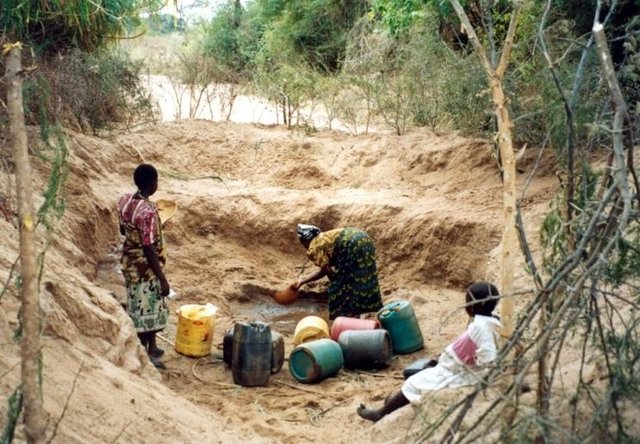
Kitui Sand dams [Кения]
Masonry dam in seasonal watercourse or river that stores water in the sand which accumulates above it.
- Составитель: Unknown User
2. Описание Подхода УЗП
2.1 Краткое описание Подхода
Community based water resource development
2.2 Подробное описание Подхода
Подробное описание Подхода:
Aims / objectives: Purpose is to harness the available water resource for common interests. Objective is to make water more accesible especially in the dry season.
Methods: Communities are mobilised through participation process. Local artisans are trained on the job wherease the community provide local materials and free labour voluntarily. Supporting NGOs facilitate the training and provide inputs eg cement, reinforcing bars, skilled labour. Community mobilisation is basic to SASOL's programme for water resource development. SASOL take advantage of existing structures and conforms to the government policy refferred to as District focus for Rural Development. Before communities can be mobilised, people, must be trained and SASOL has found that training can best be done at the local level. The role of the community is as follows: 1. To provide secondary data/information 2. Identify problems, resources and propose possible interventions or community action plan. 3. Election of a committee to take charge - custodial of all purchased materials. 4. Collection of local materials and provide labour. 5. Carry out impact assessment periodically
2.3 Фотографии, иллюстрирующие Подход
2.5 Страна/ регион/ место, где применялся Подход
Страна:
Кения
Административная единица (Район/Область):
Eastern
Map
×2.6 Даты начала и окончания реализации Подхода
Год начала реализации:
1995
2.7 Тип Подхода
- в рамках проекта/ программы
2.8 Каковы цели/ задачи Подхода
The Approach focused mainly on SLM with other activities (tree nursery establishment, health and hygiene concerns of the community. (Community Trainings))
to build sand dams in all streams in a 200km2 part of Central Division of Kitui District.
The SLM Approach addressed the following problems: Lack of water especially in dry seasonPoor water hygiene and general public health.
2.9 Условия содействующие применению Технологии/ Технологий в рамках Подхода или затрудняющие его
Наличие/ доступность финансовых ресурсов и услуг
- затрудняют
Lack of funds for cement
Treatment through the SLM Approach: SASOL raises the funds
Институциональные условия
- затрудняют
Lack of community organization to address the prevailing problems
Treatment through the SLM Approach: participatory process to identify problems & solutions
Осведомленность в области УЗП, доступность технической поддержки
- затрудняют
Lack of trained artisans
Treatment through the SLM Approach: training of artisans
другие
- затрудняют
roads and access to river valleys
Treatment through the SLM Approach: improvement of roads
3. Участие и распределение ролей заинтересованных сторон
3.1 Заинтересованные стороны, участвующие в реализации Подхода и их роли
- местные землепользователи/ местные сообщества
Community village group (water users' group). Working land users were mainly women (most of the men are working outside the district.) Existing groups of land users; Working land users were mainly women (most of the men are working outside the district.)
More men working outside the district.
More women engaged in the daily activities as they are availanle. Sub-locational development committees and self help groups are mobilised for a community training that follows the approach of a PRA. The community selects from 25 to 50 trainnees, both men and women.
- государственные власти (отвечающие за планирование или принятие решений)
- международные организации
Kenyan political scientist in collaboration with a Netherland hydrogeologist and an environmental planner
3.2 Участие местных землепользователей/ местных сообществ на разных стадиях реализации Подхода
| Участие местных землепользователей/ местных сообществ | Перечислите участников и опишите их вовлеченность | |
|---|---|---|
| инициирование/ мотивация | интерактивное | Mainly:rapid/participatory rural appraisal; partly: workshops/seminars; PRA was carried out with the assistance of world neighbours |
| планирование | интерактивное | Mainly: rapid/participatory rural appraisal; partly: public meetings; participatory planning exercise |
| выполнение | интерактивное | responsibility for major steps; collection of local materials labour water etc |
| мониторинг/ оценка | интерактивное | measurements/observations; community observation and comments |
| Research | нет | water hygiene analysis |
3.4 Принятие решений по выбору Технологии/ Технологий УЗП
Укажите, кто принимал решение по выбору применяемой Технологии/ Технологий:
- в основном землепользователи при поддержке специалистов по УЗП
Поясните:
Consultative through participatory approaches.
Decisions on the method of implementing the SLM Technology were made by mainly by SLM specialists with consultation of land users. consultative
4. Техническая поддержка, повышение компетенций и управление знаниями
4.1 Повышение компетенций/ обучение
Проводилось ли обучение землепользователей/ других заинтересованных лиц?
Да
Укажите, кто проходил обучение:
- землепользователи
- teachers, school children/students
Тип обучения:
- в ходе работы
- общие собрания
- курсы
Рассматриваемые темы:
through PRA and on the job
4.2 Консультационные услуги
Есть ли у землепользователей возможность получать консультации?
Да
Описание/ комментарий:
Name of method used for advisory service: Workshop trainning; Key elements: non residential workshops, Educational tours and visits; 1) Advisory service was carried out through: projects own extension structure and agents 2) Advisory service was carried out through: projects own extension structure and agents; Extension staff: specifically hired project employees 3) Target groups for extension: land users; Activities: SWC, Tree planting, water management
Advisory service is quite adequate to ensure the continuation of land conservation activities; community resource persons trained to make it sustainable.
4.3 Институциональная (организационная) поддержка
В ходе реализации Подхода были ли организованы новые институциональные структуры или поддержаны уже существующие?
- да, умеренно
Укажите уровень, на котором структуры были укреплены или вновь созданы:
- местные
- cooperative activity to solve water problem
4.4 Мониторинг и оценка
Являются ли мониторинг и оценка частью Подхода?
Да
Комментарии:
bio-physical aspects were ad hoc monitored
technical aspects were regular monitored
economic / production aspects were ad hoc monitored by 0 through observations; indicators: None
no. of land users involved aspects were regular monitored by 0 through measurements; indicators: None
management of Approach aspects were ad hoc monitored by 0 through observations; indicators: None
There were few changes in the Approach as a result of monitoring and evaluation: construction of dam in one single phase as opposed to several phase due to difficulties In comminity mobilisation for subsequent phases. Commencement of construction from wing walls instead of the main structure. This is psycologically attractive to land users as they remain motivated to realise completion of the dam across the river/stream bed.
5. Финансирование и внешняя материальная поддержка
5.1 Годовой бюджет мероприятий по УЗП в рамках Подхода
Если точный годовой бюжет неизвестен, укажите примерный диапазон затрат:
- 100 000-1 000 000
Комментарий (например, основные источники финансирования/ ключевые доноры):
Approach costs were met by the following donors: international (-): 50.0%; international non-government (-): 10.0%; local community / land user(s) (-): 40.0%
5.2 Финансирование и внешняя материальная поддержка, предоставляемая землепользователям
Предоставлялась ли землепользователям финансовая/ материальная поддержка для применения Технологии /Технологий?
Да
Если да, укажите тип(-ы) поддержки, кто ее предоставил и условия предоставления:
Provision of purchased inputs like cement.
5.3 Субсидии на отдельные затраты (включая оплату труда)
- оборудование
| Укажите, какие ресурсы были субсидированы | В какой степени | Опишите субсидии подробнее |
|---|---|---|
| инвентарь/ инструменты | профинансированы полностью | |
- строительные материалы
| Укажите, какие ресурсы были субсидированы | В какой степени | Опишите субсидии подробнее |
|---|---|---|
| Cement and reinforced bars | профинансированы полностью | |
Если труд землепользователя был существенным вкладом, укажите, был ли этот вклад:
- добровольный
Комментарии:
Provision of purchased inputs like cement.
5.4 Кредитование
Предоставлялись ли в рамках Подхода кредиты на мероприятия УЗП?
Нет
6. Анализ влияния и заключительные положения
6.1 Влияние Подхода
Сумел ли Подход помочь землепользователям внедрить и поддерживать технологии УЗП?
- Нет
- Да, немного
- Да, умеренно
- Да, существенно
more tree nurseries, more vegetable growing, more time for terracing etc instead of treking for water
N/A
Did other land users / projects adopt the Approach?
- Нет
- Да, немного
- Да, умеренно
- Да, существенно
other groups using water as an entry point for development e.g. catholic diocese
6.3 Долгосрочная устойчивость мероприятий в рамках Подхода
Могут ли землепользователи самостоятельно (без внешней поддержки) продолжать применение того, что было реализовано в рамках Подхода?
- нет уверенности
Если нет или нет уверенности, объясните почему:
Still need help for purchase of inputs especially cement and reinforced bars
6.4 Сильные стороны/ преимущества Подхода
| Сильные стороны/ преимущества/ возможности по мнению землепользователей |
|---|
| avail labour readily for demanding activities (How to sustain/ enhance this strength: engage groups in self help farm activities) |
| laggards are pulled along by innovators |
| communal identification of available resources and strngths |
| Сильные стороны/ преимущества/ возможности по мнению составителя или других ключевых специалистов |
|---|
| Participatory PRA creates awareness (How to sustain/ enhance this strength: through trainings) |
| empowers community (How to sustain/ enhance this strength: start income generating activities) |
| costs minimized through voluntary labour |
| self reliance strengthened |
| community empowered |
6.5 Слабые стороны/ недостатки Подхода и пути их преодоления
| Слабые стороны/ недостатки/ риски по мнению землепользователей | Возможные пути их преодоления/снижения? |
|---|---|
| materials are too expensive for them to afford | local fund raising initiatives |
| Слабые стороны/ недостатки/ риски по мнению составителя или ответственных специалистов | Возможные пути их преодоления/снижения? |
|---|---|
| impact on river flow needs to be studied |
7. Справочные материалы и ссылки
7.1 Методы сбора/источники информации
- выезды на места, полевые обследования
- опросы землепользователей
7.2 Ссылки на опубликованные материалы
Название, автор, год публикации, ISBN:
Thomas, D.B. 1999'where there is no water.' A story of community water development & dand dams in Kitui District, Kenya
Ссылки и модули
Развернуть все Свернуть всеСсылки

Kitui Sand dams [Кения]
Masonry dam in seasonal watercourse or river that stores water in the sand which accumulates above it.
- Составитель: Unknown User
Модули
Нет модулей


